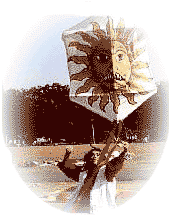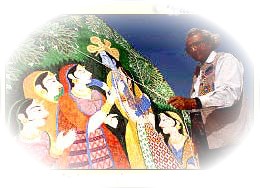| INTERNATIONAL
KITE FESTIVAL |
|
| Celebrated In
:
Ahmedabad, Gujarat. |
|
| Held on :
14th January, Every Year. |
|
| To Celebrate :
Makar Sankranti |
|
| Attractions :
Colourful kites of sizes
and hues. |
|
|
|
| International Kite Festival is held at
Ahmedabad on January 14 every year, to coincide with the festival of Uttarayan
or Makar Sankranti. Makar Sankranti is a festival that heralds a change of
season marking the movement of the sun into the northern hemisphere - a
celebration to mark the end of winter. The skies are blue and clear, a cool
breeze blows and a feeling of anticipation, joy and jubilation grips all who
celebrate the occasion. |
|
In Gujarat, Makar Sankranti is celebrated as
the kite-flying day. Kite-flying day in Gujarat is an extraordinary day, unlike
at other places. Ahmedabad, Gujarat's premier city, leads the way in the
celebration of Uttarayani, and is the venue of the International Kite Festival.
Kite-flying festival is being held in important cities of Gujarat each year.
The festival draws expert kite-makers and flyers not only from cities of India
but also from around the world. Designer's Kites of infinite variety are
displayed at the venue.
|
 |
|
|
THE BELIEF :
The festival is a time of thanksgiving for the religious, since it marks the
awakening of the gods from their long slumber. The gods who are believed to
have slumbered for six long months are now awake and the portals of heaven are
thrown open. It is also a signal for merry-making.
The temples are thronged with visitors and alms are distributed freely.
|
|
KITES OF ALL HUES
:
From dawn to dusk, people of all ages fly kites rejoicing in the spirit of the
day. The blue January sky is enlivened by kites of different colours and hues.
Kites soar in the sky, their lines moving as if alive. Crowded rooftops,
fun-loving rivalry to outdo each other, and delicious Gujarati feast are the
hall-marks of the day. |
|
| A tremendous variety of kites are seen with
friends, neighbours and total strangers indulging in kite fights. The nights
see the arrival of the illuminated box kites, often in a series strung on one
line, to be launched into the sky. Known as Tukkals, these kites add a touch of
splendour to the dark sky. |
|
THE EXPERT TOUCH :
The festival draws expert kite-makers and flyers not only from cities of India
but also from around the world. Special mixtures of glue and ground glass cover
the lines with which the kites are flown. Experts specially prepare these lines
before the great day. They are dried and rolled onto reels known as 'firkees'.
Unless used carefully the strings are sharp enough to cut a finger. |
|
 |
HISTORY OF KITE FLYING
:
In fact, kite flying has a fascinating history; man had the desire to fly since
time immemorial. It was the spirit of man and his imagination that ultimately
saw the invention of kites. Their fascinating history is depicted in the Kite
Museum of Ahmedabad.
200 BC : Huein Tsang flew a kite at night to overawe the army of Liu
Pang of Han dynasty in china. |
|
|
| 100 BC to 500 AD : Kites were used by
the army generals to send signals and to measure the distance of enemy camps.
|
|
| 930 AD : The earliest mention of
"Shiroshi" in Japanese literature where 'Shi' means paper and 'Roshi' stands
for the Chinese bird. |
|
| 960 to 1126 AD : Flying kites became a
popular activity of recreation in China. People celebrated the 9th day of the
ninth month, a day signifying the banishment of evil, by flying kites. |
|
| 1542 AD : For the first time the word '
Patang' finds mention in Indian literature. It was used by Manzan in
'Madhumalti', where the flight of a kite is associated with the loved one by a
poet.
|
|
| 1752 AD : Benjamin Franklin lofted a
kite to prove that lightning was of the same electric matter as the one that
generated electricity.
|
|
| Wooden sticks were affixed to four corners of
a square silk handkerchief and a projecting metal wire with sharp edge was
attached to it. When an electrified cloud passed over the kite, lightning was
drawn down through the pointed wire.
|
|
| 1870 AD : Australian inventor Lawrence
Hargrave designed box-kites whose stability inspired others to create power
driven aeroplanes.
|
|
| 1896 AD : Alexander Graham Bell
designed ' tetra' by combining lightweight sticks. He flew 'Frost King" kite of
256 cells and improvised it to have 1300, and later 3393 cells.
|
|
| At this time, Samuel Cody carried out
experiments with man carrying diplane gliders.
|
|
| 1902 AD : Cody's contemporary, the
Wright brothers, were successful in becoming airborne, age of aviation begins.
|
|
|
|
|
|